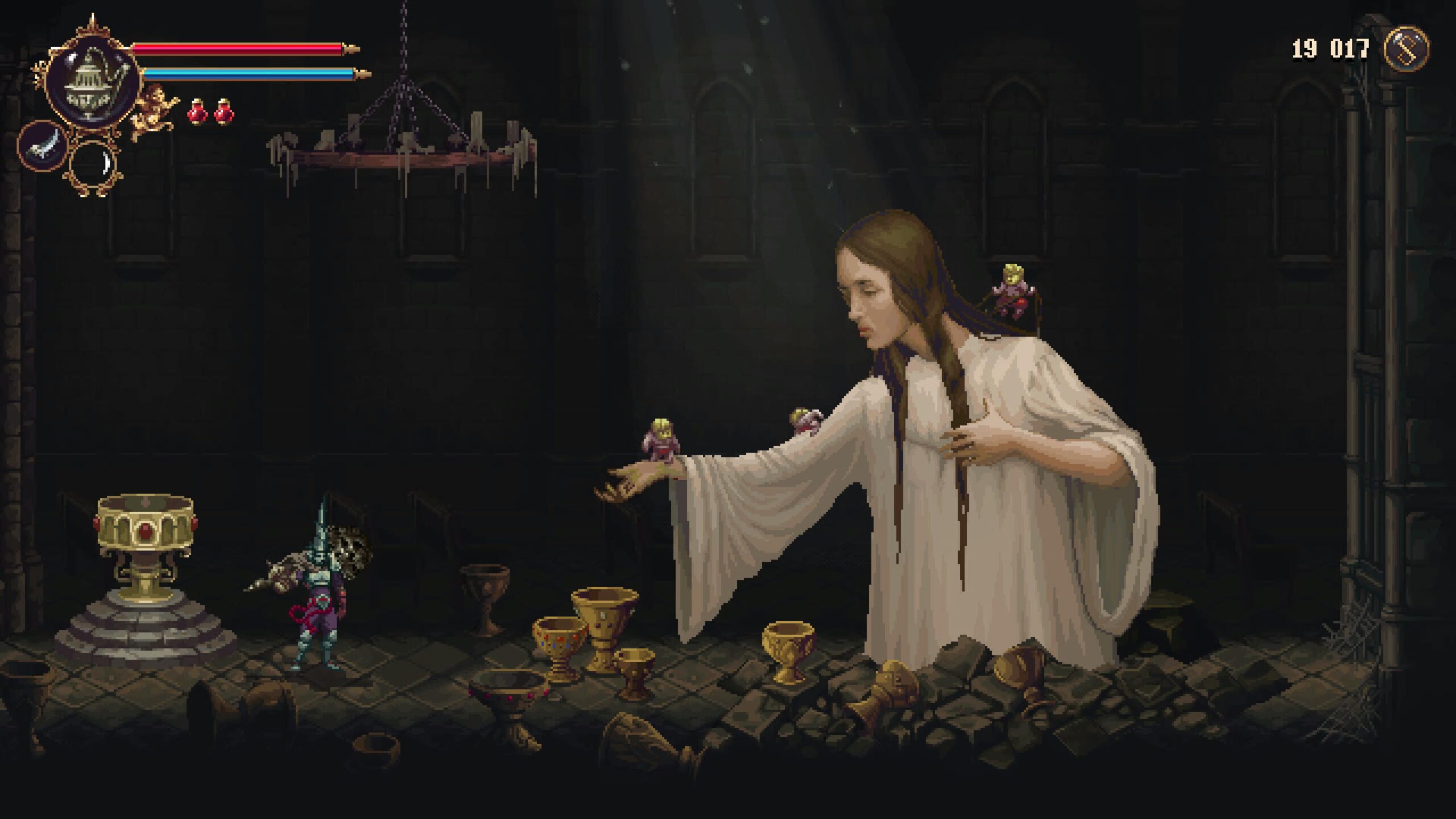At the end of 2019, the Spanish studio The Game Kitchen dropped the indie survival horror to embark on metroidvania. A genre already much more present on the indie scene than the horrific point & click with which the studio cut its teeth. This is how Blasphemous was born, a hardcore platform game, metroidvania therefore, which plunges the player into a dark, anxiety-provoking, cryptic and horrifying universe, inspired by Andalusian mythology, religions and many other subjects of the genre. . The result, although imperfect, remains surprising and largely suits its needs. A great success and a DLC later, the studio is back with a second part.
Suffice to say that the latter knew how to make the sauce rise. Blasphemous 2 is indeed one of the most anticipated indie games of the moment. Its DNA halfway between metroidvania and souls-like, mixed with a universe that once again promises to be atypical and cryptic, is enough to make your mouth water. But is this new infernal roadtrip worth the detour or will it force us to do penance too?
A bloody new pilgrimage
Blasphemous crashes its plot after the events of the ultimate DLC of the first opus, Woods of Eventide. The world braces for the arrival of a new offspring of the Miracle, a destructive force growing in a heart clinging to the clouds above the City of the Blessed Name, now carried at arm’s length by huge statues under the frightened gaze of a people awaiting their final judgement.
It is then your duty, as a Penitent, to remedy this before a new cycle strikes. So much for the red thread that will quickly be thrown before our eyes at the launch of a new pilgrimage. Blasphemous 2 does not steal its name and once again anchors its story and its universe in a fantastic world with obvious mythological and religious inspirations. Religion, perverted, is once again the blood, the heart and the spirit of this world and the developers have once again succeeded in creating both unease and fascination.
The universe of Blasphemous 2 is still cryptic, although it is revealed more through pretty animated cutscenes and some dialogues with NPCs supposed to guide us. Our hero, the Penitent, stuck in a cycle of life, death and eternal resurrection, always remains mute and decked out in a huge conical helmet, a symbol of his pilgrimage and more. Although he wakes up from a long sleep, the latter has not lost his hand when it comes to using weapons and magic to decimate the perverted entities that stand in his way. His mission, sacred as it may be, is to kill the offspring of the Miracle that grows in the heavens. A difficult task that will require us to find and face bloodthirsty bosses in order to bend the titanic statues that carry the city and the burden of the end times. Blasphemous 2 is a particularly difficult title which, in addition to its metroidvania aspect which pushes us to explore and travel against a background of back and forth, is based on well-known souls-like mechanics by now. We move on, we try, we die, we come back to life, and so on.
A painful journey
The die & retry, a cycle of gameplay which here takes on a downright religious dimension since it is excused by the plot. But deep down, we know the song. When we die, we leave behind a mark that we will have to pick up to recover the life and experience lost in battle. The subtlety here is that Blasphemous 2 punishes death more than it uses to teach the player how to evolve. Dying does indeed permanently reduce our magic gauge. In addition, each death (like each of our murderous acts) fills a receptacle making the gains in experience and resources greater, while increasing the difficulty. It will be possible to wash away your sins with a certain NPC fairly quickly in the game in order to put everything back in order, but sometimes the risk is worth it. It’s for you to see.
But even without this mechanic, Blasphemous would be quite a difficult game, although it is not insurmountable as far as we can tell. The enemies, many of whom are already known from the first episode, are not kidding. Each of them, no matter how weak in appearance, is a potential threat. Some can even kill you in a few hits without giving you a chance to defend yourself if you take the first bad hit in the face. It may be intentional, but it’s also sometimes frustrating. But those who made the first episode know that very well, Blasphemous doesn’t care and isn’t really there to take you by the hand.

And the bestiary will quickly let you know. The creatures are very numerous, varied, and swarm absolutely everywhere. We have very little respite in the end, and when a room is empty it’s either that a trap or an ambush is hidden there, or that the next room will bend over backwards. We won’t complain, we’re here for that, and facing hordes of monstrosities like this is part of Penitent’s job after all. Especially since it is rather pleasant to face the kids. Not only are they rather stylish, even if, as said above, many enemies were already in the first opus and/or the DLCs.
The bosses and the mid-bosses are not left out either. Often very inspired, the fights are generally intense and addictive, with a few exceptions, and you may find yourself doing it several times very often. As in the first opus, the developers have set the bar very high in terms of character design. But if they are classy, the bosses are also very devious for the most part and the blows are not forgiving. It will be necessary to show composure, even if there is nothing insurmountable. The patterns have the merit of being for the most part very readable and learning is done without having to rack your brains thinking about 200 strategies. Blasphemous is difficult, yes, but clearly not unlivable. In addition, it has the merit of being based on a basic combat system (with a few keys) but effective and above all, the rise in power is well done.

The Penitent suffers more than ever in Blasphemous 2
The Penitent that we are will have access to several weapons and will only be able to choose one at the start of the game. The latter can also influence the progress of our pilgrimage since the capacities of the weapon we have will be used to unlock paths. For example, the flail, slow but very powerful, can ring bells opening passages and causing platforms to appear there. The sword as for it, versatile and allowing to parry the blows, will offer us the opportunity to destroy the brambles. The initial choice of weaponry will therefore influence the way you approach the first fights as much as the start of your journey.
In combat, each weapon has its style of play. Quick hits, parry, range… it’s up to you to find your playstyle. If the arsenal only includes a handful of different weapons, their gameplay is different enough to suffice, especially since a skill tree will optimize your style of play with each of them. It will simply be enough to gain experience to spend points in order to get your hands on passive or active abilities that can drastically modify your approaches. The flail for example, my weapon of choice during this test, can ignite to do additional damage with faith (the equivalent of mana). He will also be able to deliver very powerful charged blows, break defenses, etc.

To this arsenal is added a little magic, songs and odes that can be equipped on the fly after having gleaned them while exploring or from merchants. Very diverse, these spells can inflict damage as well as hinder your opponents or even heal you, defend you. Finally, on the statistics side, if there is no traditional equipment management, you can equip yourself with effigies. These small statuettes can also be found here in the field or with a sculptor who will be given objects in order to have ever more powerful novelties. The effigies allow you to gain useful statistics (additional damage, resistance, gain of resources, etc.) and can be changed as you see fit.
There are also many NPCs capable of providing more or less useful services. However, it will be your duty here to find out what they are used for. Already because I don’t want to spoil you, but also because even having finished the game after twenty hours of hard work, I still have things to discover. So do the same, experiment, explore and discover. This is also the essence of Blasphemous 2.

Blasphemous 2 is to die for
The game also fully embraces its Metroidvania and Souls-like inspirations here. Blasphemous 2 is non-linear and (almost) open-world. You can go wherever you want from the start. Only your equipment will prevent you from reaching certain areas initially and, as explained, the start of your journey will depend not only on the direction you take, but also on the first weapon you choose. There is therefore no right or wrong way to explore the vast labyrinthine world that is given to you. In the end, there is only one pilgrimage that will make you sweat blood and water. And it’s a great thing that, as a bonus, will offer a little replayability for the most hardcore fans who would like to try the adventure again after the credits. Eventually something quite rare in genre games which generally have a well-drawn plot with a pre-established order of objects and skills to unlock to move in the right direction.
On this, Blasphemous 2 does a nice job, and we like to get lost in it. The artistic direction is still as tasty and the pixel art is ultra mastered. The studio knows how to create tortured, gore, uncomfortable and fascinating universes at the same time. The world of Blasphemous 2 is stronger than the first opus with finer, more detailed environments, despite a few repetitions here and there that will especially be felt by players who have already sanded the previous opus and the DLCs of the latter. But never mind, the trip is worth the detour, and the map of the world makes you dizzy. Fortunately, the mini-map is clear enough to allow you to find your way around effectively, but getting lost is still easy.
If the biomes are varied and very different, within the same environment, the backgrounds and the often very detailed artistic direction do not really help to create clear reference points.
However, the developers have designed their world smart enough to allow players to unlock a large number of paths. We will therefore quickly create useful shortcuts. Of course, Blasphemous 2 hides a huge amount of secrets and backdoors that often lead to juicy rewards. Secret passages, hidden walls, puzzles… it ticks all the boxes.
Impossible to conclude the test without mentioning the OST, just as tasty as that of the first opus. We are on something once again particularly dark, with notes sometimes epic, sometimes metal, sometimes disastrous, but it’s always a treat.
